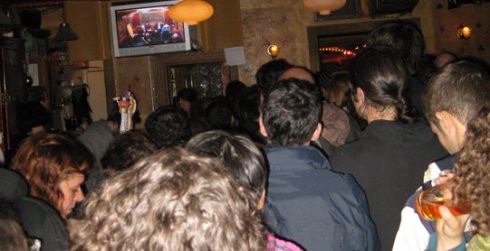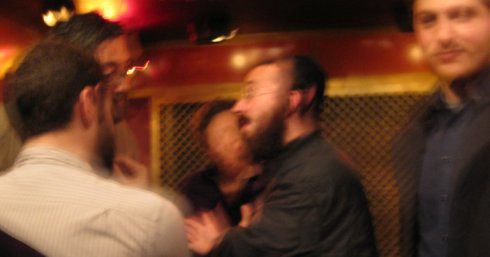The Spandex Report, with Erica Sackin: The Great Bedford Avenue Bike Lane Debate
by Erica Sackin

On Monday night, Pete’s Candy Store-on Lorimer Street, in Williamsburg-was packed. Flannel shirts, skinny jeans and thick-framed glasses with people inside them filled every seat, blocked the door and spilled out into the street. Outside the bar, there were two cops wearing “Community Outreach” jackets and also a smattering of Hasidic men. This was because people in Williamsburg really care about bike lanes, and so they had all showed up for a “debate” about a recently-disappeared Bedford Avenue bike lane.

The Department of Transportation eliminated the bike lane in early December, saying that the bike lanes two blocks away on Berry Street and three blocks away on Kent Avenue were more than sufficient for bike traffic.
Among bikers, outrage ensued. One attendee at Pete’s, Heather Loop, who has been described as your “typical anarchist bike punk”-that means tattoos, messenger bag, skinny jeans and an attitude-had even organized a topless bike ride in protest, due to a belief that the Hasidim had caused the bike lane to be closed due to horror at bike-riding womens’ bare arms and legs.
That protest was canceled due to snow-”I care too much about my nipples to lose them to 25 degree weather,” she said-but the underlying idea has lingered: they don’t like scantily clad ladies. (A related notion also circulates; Brooklyn women bikers also talk, perhaps sometimes apocryphally, about being regularly and overtly propositioned-for sex, no less!-by Hasidim.)
The Hasidic community, on the other hand, insists their opposition has more to do with parking and safety, especially as they are not upset at all by the bare arms and legs of bikers on the other Brooklyn bike lanes.
“The other day my daughter was knocked over by a biker,” said Leo Moskowitz, one of the few Hasidic men in attendance that night. “The press is trying to paint this as about modesty, but that’s not the issue. This is a community with a lot of kids. That’s why I have a minivan-when I go to the grocery store, how else am I supposed to bring five kids? Yet the bike lane took 100 parking spots away.”
So why the outrage when there are other, safer bike lanes so close by? Yes, Bedford Avenue is a main street that leads right to the Williamsburg Bridge. And yes, with the number of accidents that happen to bike riders every year, the last thing the City needs to be doing is taking away bike lanes. But perhaps more than anything else, it’s because the removal of the bike lane on Bedford Avenue was just so super-sketchy.

“There was a very long community process to put the bike lane on Bedford Avenue, and then overnight, it was gone,” said Brian Sweeny, 26, of the Freegan Bike Workshop. “It would be great if the DOT would come and say something.”
“The DOT and Bloomberg made some sort of deal with the Hasidic community, that they’d all vote for him and if he won reelection he’d remove the bike lane,” said Tamara Kneese, 25, repeating a theory I heard often that night. “They’re a strong community and vote as a monolithic block. They have a lot of power.”
“From what I see, there is actually a lot of violence, like people dooring bikers in the line of traffic,” said Sweeny. “There is a very painful rift between the Hasidic community and any other community. They have their own police force, their own hospitals, their own language, their own unique style of dressing.”
“Repainting those lines was a knee jerk reaction to the idea that special interest groups could pay off our city government to have something removed,” said a bike activist who was refused to give his name but who was involved in repainting the bike lane. “I think the fact that it was all over the papers was an embarrassment to the Bloomberg administration.”
Clearly there is a rift between these two communities, at least-even as they interact, and sometimes even overlap, as in the case of those rare hipster Hasids one spots from time to time in bars.
“In reality, as someone who lives in South Williamsburg, there’s a lot of interaction between the two communities,” said Kneese. “I work out in a gym where there are Hasidic men and women on the treadmill next to me. I’ve been asked to light a Hasidic man’s cigarette for him on Sabbath.”
In the end, the debate did very little to bring the two sides together. At one point, Isaac Abraham told a joke about statistics, in response to a claim about the number of bike accidents caused by drivers.
“Nine women are sitting in a doctor’s waiting room,” he said, “and one of them is nine months pregnant. The doctor comes out and says ‘statistically, each of you are one month pregnant.’ And eight of the women want to kill him.”
The crowd groaned. Heather Loop stood up with a joke in response.
“They say bike wheels are like tits,” she said. “One is too few, and four is too many.”

Erica Sackin writes and lives in Brooklyn. She was once a contestant in the Ms. G Train competition, but lost. ‘The Spandex Report’ covers the lives of the youngs.
